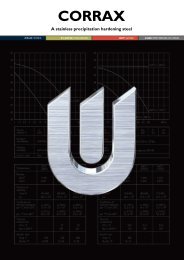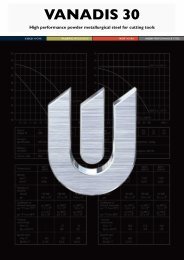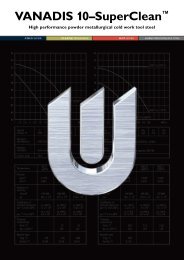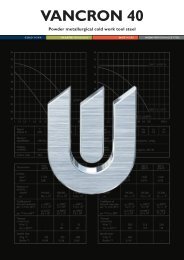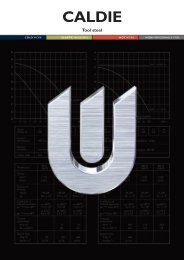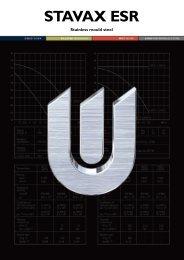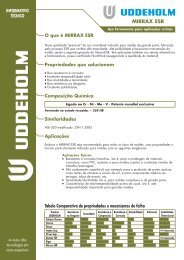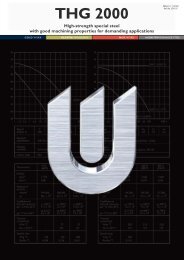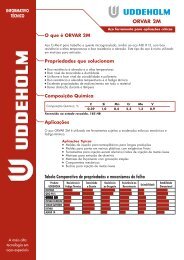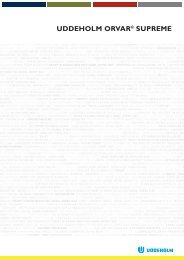VANADIS 6âSuperCleanâ¢
VANADIS 6âSuperCleanâ¢
VANADIS 6âSuperCleanâ¢
Create successful ePaper yourself
Turn your PDF publications into a flip-book with our unique Google optimized e-Paper software.
<strong>VANADIS</strong> 6–SuperClean High performance powder metallurgical cold work tool steel
<strong>VANADIS</strong> 6Cover photo:Powder pressing punch of <strong>VANADIS</strong> 6.Excellent result has been obtained for pressing ironpowder when abrasive wear reduce the punch life.(Courtesy GKN Sinter Metals AB, Kolsva.)This information is based on our present state of knowledge and isintended to provide general notes on our products and their uses.It should not therefore be construed as a warranty of specificproperties of the products described or a warranty for fitness for aparticular purpose.2
<strong>VANADIS</strong> 6Critical tool steelparameters forGOOD TOOL PERFORMANCE• Correct hardness for the application• Very high wear resistance• High toughness to prevent premature failuredue to chipping/crack formation.High wear resistance is often associated with lowtoughness and vice-versa. However, in many casesboth high wear resistance and toughness are essentialfor optimal tooling performance.<strong>VANADIS</strong> 6 is a powder metallurgical cold worktool steel offering a combination of very high wearresistance and good toughness.TOOLMAKING• Machinability• Heat treatment• Dimensional stability in heat treatment• Surface treatment.Toolmaking with highly alloyed tool steels meansthat machining and heat treatment have to bemore considered than with the lower alloyedgrades. This can, of course, raise the cost of toolmaking.Due to the very carefully balanced alloying andthe powder metallurgical manufacturing route,<strong>VANADIS</strong> 6 has a similar hardening procedure asthe common cold work tool steels. In order to reducethe amount of retained austenite and tooptimize the abrasive wear resistance high temperaturetempering is recommended. One very bigadvantage with <strong>VANADIS</strong> 6 is that the dimensionalstability after hardening and tempering is muchbetter than for the conventional produced coldwork steels and for HSS used for cold work. Thisalso means that <strong>VANADIS</strong> 6 is a tool steel which isvery suitable for CVD and PVD coating.Applications<strong>VANADIS</strong> 6 is suitable for long run tooling of workmaterials where mixed (abrasive–adhesive) orabrasive wear and/or chipping/cracking and/orplastic deformation are dominating failure mechanisms.Examples:• Blanking and fine blanking of harder workmaterials• Forming operations where a high compressivestrength is essential• Powder pressing• Substrate steel for surface coating• Plastic moulds and toolings subjected to abrasivewear conditions• Knives.General<strong>VANADIS</strong> 6 is a chromium-molybdenum-vanadiumalloyed PM steel which is characterized by:• Very high abrasive-adhesive wear resistance• High compressive strength• Good toughness• Very good dimensional stability at heat treatmentand in service• Very good through-hardening properties• Good resistance to tempering back• High cleanliness.Typical C Si Mn Cr Mo Vanalysis % 2,1 1,0 0,4 6,8 1,5 5,4DeliveryconditionColourcodeSoft annealed to approx. 255 HBGreen/Dark greenRaufoss Teknologi AS, Verktygsfabriken, Norway.3
<strong>VANADIS</strong> 6PropertiesPHYSICAL DATAHardened and tempered to 60 HRC.Temperature 20°C 200°C 400°C(68°F) (390°F) (750°F)Densitykg/m 3 7 610 – –lbs/in 3 0,27 – –Modulus ofelasticityMPa 225 000 210 000 190 000psi 32,6 x 10 6 30,4x 10 6 27,5 x 10 6Coefficientof thermalexpansion per°C from 20°C – 11,2 x 10 -6 12,0 x 10 -6°F from 68°F – 6,2 x 10 -6 6,7 x 10 -6ThermalconductivityW/m • °C – 22 25Btu in/(ft 2 h °F) – 154 175Specific heatcapacityBtu/lb°F 0,110 – –J/kg°CIMPACT STRENGTHApproximate room temperature impact strength atdifferent tempering temperatures.Specimen size: 7 x 10 x 55 mm (0,27 x 0,40 x 2,2")unnotched. Hardened at 1050°C (1920°F).Quenched in air. Tempered 2 x 2h.Impact energy (J)6040Hardness HRC6560Approximate room temperature impact strengthfor <strong>VANADIS</strong> 4, <strong>VANADIS</strong> 6 and <strong>VANADIS</strong> 10 at62 HRC. Transverse direction. High temperaturetempered conditionImpact energy (J)3025201510WEAR RESISTANCEPin on disc test. Disc material SiO 2 . Hardness is62 HRC for all steels. High temperature temperedcondition. Low value is equivalent to good wearresistance.Wear rate (mg/min)7650<strong>VANADIS</strong> 4 <strong>VANADIS</strong> 6 <strong>VANADIS</strong> 10COMPRESSIVE STRENGTHCompressive strengthHardnessRc0,2, MPa60 HRC 2 29062 HRC 2 53064 HRC 2 760High temperature tempered, 525°C (977°F) 2 + 2h.205554050200 300 400 500 600°C390 570 750 930 1110°FTempering temperature (2h + 2h)3210<strong>VANADIS</strong> 4 <strong>VANADIS</strong> 6 <strong>VANADIS</strong> 104
<strong>VANADIS</strong> 6Heat treatmentSOFT ANNEALINGProtect the steel and heat through to 900°C(1650°F). Then cool in the furnace at 10°C (20°F)per hour to 750°C (1380°F), then freely in air.STRESS RELIEVINGAfter rough machining the tool should be heatedthrough to 650°C (1200°F), holding time 2 hours.Cool slowly to 500°C (930°F), then freely in air.HARDENINGPre-heating temperature: normally in two pre-heatingsteps; 600–650°C (1110–1200°F) and 900–950°C (1650–1740°F).Austenitizing temperature: 1000–1100°C (1830–2010°F). Normally 1050°C (1920°F).Holding time: 30 min. below 1100°C (2010°F),15 min. above 1100°C (2010°F).Protect the tool against decarburization and oxidationduring hardening.QUENCHING MEDIA• High speed gas/circulating atmosphere• Vacuum (high speed gas with sufficient positivepressure), preferably at least 4–5 bar• Martempering bath or fluidized bed at500–550°C (930–1020°F)• Martempering bath or fluidized bed at approx.200–350°C (390–660°F).Note 1: Temper the tool as soon as its temperaturereaches 50–70°C (120–160°F).Note 2: In order to obtain the optimum propertiesfor the tool, the cooling rate should be as fast as isconcomitant with acceptable distortion.Note 3: Tools with sections >50 mm (2") should bequenched in sufficient gas pressure and speed.Quenching in still air will result in loss of hardness.Hardness and retained austenite as functions ofaustenitizing temperature.Hardness HRC68676665As quenchedhardnessRetained austenite %6415Retained austenite6310625610980 1000 1020 1040 1060 1080 1100 1120 1140 °C1780 1830 1870 1900 1940 1980 2010 2050 2080 °FAustenitizing temperatureTEMPERINGThe tempering temperature can be selected accordingto the hardness required by reference tothe tempering graph below. Temper minimumtwice with intermediate cooling to room temperature.The lowest tempering temperature which shouldbe used is 180°C (360°F). This temperatureshould only be used for small and uncomplicatedtools.For medium to large size and more complicatedtools a temperature of 250°C (480°F) or highershould be used. When performing a high temperaturetemper, a temperature to the right of the secondaryhardening peak should be chosen.At a hardening temperature of 1100°C (2010°F) orhigher <strong>VANADIS</strong> 6 must be tempered three times(holding time 1 hour) at minimum 525°C (980°F)in order to reduce the amount of retained austenite.Otherwise the minimum holding time at temperatureis 2 hours.35302520Electrical components blanked with <strong>VANADIS</strong> 6 punch.5
<strong>VANADIS</strong> 6Tempering graphsHardness HRC666462Retained austenite %1050°C(1920°F)353025Hardness HRC666462Retained austenite %351100°C(2010°F)301080°C(1975°F)2560581000C(1830°F)1020°C(1870°F)201560581150°C(2100°F)2015565452Retained austenite1050°C (1920°F)0200 300 400 500 600°C390 570 750 930 1110°FTempering temperature (2h + 2h)105565452Retained austenite1100°C (2010°F)0200 300 400 500 600°C390 570 750 930 1110°FTempering temperature (2h + 2h)105Tempering at high temperature after deepcooling (sub-zero cooling).The tempering temperature should be lowered25°C (50°F) in order to get the desired hardnesswhen a high temperature temper is performed.DIMENSIONAL CHANGESThe dimensional changes have been measuredafter austenitizing at 1050°C/30 min. (1920°F/30 min.) followed by gas quenching in a coldchamber vacuum furnace.Specimen size: 65 x 65 x 65 mm (2,5" x 2,5" x 2,5" )Austenitizing temperature 1050°C (1920°F)SUB-ZERO TREATMENTPieces requiring maximum dimensional stabilitycan be sub-zero treated as follows:Immediately after quenching the piece should besub-zero treated to between –70 and –80°C (–95 to–110°F), soaking time 1–3 hours, followed by tempering.The tempering temperature should be lowered25°C (50°F) in order to get the desired hardnesswhen a high temperature temper is performed.Sub-zero treatment will give a hardness increaseof ~1 HRC. Avoid intricate shapes as therewill be risk of cracking.For the highest demands of dimensional stabilitysub-zero cooling in liquid nitrogen is recommendedafter quenching and each tempering.Dimensional changes %+0,10+0,08▲525°C(980°F)+0,06+0,04+0,020–0,02–0,04Temperingtemperature200°C(390°F)L T SL T S–0,06–0,08L =Length, T =Transverse, S =Short transverseParts blanked in a <strong>VANADIS</strong> 6 tool from AllenvaleTools & Production Ltd., Great Britain.6
<strong>VANADIS</strong> 6TTT-graphAustenitizing temperature 1050°C (1920°F). Holding time 30 minutes.Temperature°F °C2000 11001800 10009001600800140070012006001000500800400600300400 200200 100M sCarbidesMartensiteAustenitizing temperature 1050°CHolding time 30 min.PearliteBainite1 10 100 1 000 10 10000 100 000 Seconds1 10 100 1 000 Minutes1 10 100 Hours HoursA C1f920°C (1690°F)A C1s835°C (1535°F)Temp. Time Hardness°C. hours HV10800 2,25 824750 4,08 306700 0,48 394650 2,17 464600 16,56 882450 6,41 882400 16,35 920350 16,35 870300 2,15 857250 5,42 642200 2,13 870CCT-graphAustenitizing temperature 1050°C (1920°F). Holding time 30 minutes.Temperature°F °C2000 11001800 10001600900140080070012006001000500800400600 300400 200200 100M sMartensiteCarbidesPearliteBainite1 Martensite2 3 4 5 6 7 8Austenitizing temperature 1050°CHolding time 30 min.1 10 100 1 000 10 000 100 000 Seconds1 10 100 1 000 Minutes1 10 100 HoursAir cooling of0,2 1,5 10 90 600 bars, Ø mm0,0079 0,059 0,394 3,54 23,6 inchA C1f920°C (1690°F)A C1s835°C (1535°F)Coolingcurve Hardness *T 800–500No. HV 10 (sec)1 870 22 870 313 870 1404 870 2805 870 4506 762 10307 498 32058 351 5215*T 800–500 = cooling timebetween 800–500°C(1472–935°F)7
<strong>VANADIS</strong> 6Surface treatmentSome cold work tool steels are given a surfacetreatment in order to reduce friction and increasewear resistance. The most commonly used treatmentsare nitriding and surface coating with wearresistant layers produced via PVD or CVD.The high hardness and toughness together with agood dimensional stability makes <strong>VANADIS</strong> 6ideal as a substrate steel for various surface coatings.NITRIDING AND NITROCARBURIZINGNitriding and nitrocarburizing result in a hardsurface layer which is very resistant to wear andgalling.The surface hardness after nitriding is approximately1250 HV 0,2 kg . The thickness of the layershould be chosen carefully, considering the highalloying elements, to suit the application in question.PVDPhysical vapour deposition, PVD, is a method ofapplying a wear-resistant coating at temperaturesbetween 200–500°C (390–930°F).CVDChemical vapour deposition, CVD, is used for applyingwear-resistant surface coatings at a temperatureof around 1000°C (1830°F). It is recommendedthat the tools should be separately hardenedand tempered in a vacuum furnace after surfacetreatment.Blanked parts. Punch in <strong>VANADIS</strong> 6,die in <strong>VANADIS</strong> 10.8
<strong>VANADIS</strong> 6MachiningrecommendationsThe cutting data below, valid for <strong>VANADIS</strong> 6 insoft annealed condition, are to be considered asguiding values which must be adapted to existinglocal conditions.TURNINGTurning with carbide TurningCutting data Rough Fine with HSSparameters turning turning Fine turningCutting speed (v c )m/min. 70–100 100–120 8–10f.p.m. 230–330 230–395 23–33Feed (f)mm/r 0,3–0,6 – 0,3 – 0,3i.p.r. 0,012–0,023 – 0,012 – 0,012Depth of cut (a p )mm 2–6 – 2 – 2inch 0,08–0,23 – 0,08 – 0,08Carbidedesignation ISO K20 K15 –US C3 C3 –Coated Coatedcarbide carbideDRILLINGHigh speed steel twist drillDrill diameter Cutting speed (v c ) Feed (f)mm inch m/min f.p.m. mm/r i.p.r.–5 –3/16 8* 26* 0,05–0,10 0,002–0,0045–10 3/16–3/8 8* 26* 0,10–0,20 0,004–0,00810–15 3/8 –5/8 8* 26* 0,20–0,25 0,008–0,01015–20 5/8 –3/4 8* 26* 0,25–0,30 0,010–0,012* For coated HSS drills v c ~14 m/min. (46 f.p.m.).MILLINGFace and square shoulder millingMilling with carbide Milling withCutting data Rough Fine HSSparameters milling milling Fine millingCutting speed (v c )m/min. 50–70 70–100 12f.p.m. 165–230 230–330 40Feed (f z )mm/tooth 0,2–0,4 0,1–0,2 0,1in/tooth 0,008–0,016 0,004–0,008 0,004Depth of cut (a p )mm 2–4 1– 2 – 2inch 0,08–0,2 0,04– 0,08 – 0,08Carbidedesignation ISO K20 K15 –US C3 C3 –Coated Coatedcarbide carbideEnd millingType of millingCutting data Solid Carbide index- High speedparameters carbide able insert steelCuttingspeed (v c )m/min. 40 70–90 7 1)f.p.m. 130 200–260 23 1)Feed (f z )mm/tooth 0,03–0,2 2) 0,08–0,2 2) 0,05–0,35 2)in/tooth 0,001–0,008 2) 0,003–0,008 2) 0,002–0,014 2)CarbidedesignationISO K10, P40 K15 –US C3–C5 C3 –1)For coated HSS end mill v c ≈ 23 m/min. (76 f.p.m.).2)Depending on radial depth of cut and cutter diameter.2) 2) 2) Face grindingGRINDINGCarbide drillType of drillA general grinding wheel recommendation isgiven below. More information can be found in theCutting data Indexable Solid BrazedUddeholm publication “Grinding of Tool Steel”.parameters insert carbide carbide 1)Wheel recommendationCuttingspeed (v c )m/min. 90–120 60 30Soft annealed Hardenedf.p.m. 300–395 200 100Type of grinding condition conditionFeed (f)Face grinding A 46 HV B151 R50 B3mm/r 0,05–0,25 2) 0,10–0,25 2) 0,15–0,25 2) straight wheelA 46 GVi.p.r. 0,002–0,01 0,004–0,01 0,006–0,011)Drills with internal cooling channels and a brazedsegments A 36 GV A 46 GVcarbide tip.2)Depending on drill diameter.Cylindrical grinding A 60 KV B151 R50 B3A 60 JVInternal grinding A 60 JV B151 R75 B3A 60 IVProfile grinding A 100 IV B126 R100 B6A 100 JV9
<strong>VANADIS</strong> 6Electrical-dischargemachining–EDMIf EDM is performed in the hardened and temperedcondition, finish with “fine-sparking”, i.e.low current, high frequency.For optimal performance the EDM’d surfaceshould then be ground/polished and the toolretempered at approx. 25°C (50°F) lower than theoriginal tempering temperature.When EDM’ing larger sizes or complicated shapes<strong>VANADIS</strong> 6 should be tempered at high temperatures,above 500°C (930°F).Further informationPlease, contact your local Uddeholm office forfurther information on the selection, heat treatment,application and availability of Uddeholm toolsteels.Relative comparison ofUddeholm cold work tool steelMATERIAL PROPERTIES AND RESISTANCE TO FAILURE MECHANISMSGradeHardness/Resist. toplasticdeformationMachinabilityGrindabilityDimensionalstabilityAbrasivewearResistance toAdhesivewearDuctility/chippingToughness/grosscrackingCALMAXSVERKER 21<strong>VANADIS</strong> 4<strong>VANADIS</strong> 6<strong>VANADIS</strong> 10<strong>VANADIS</strong> 23<strong>VANADIS</strong> 30<strong>VANADIS</strong> 60AISI M210





